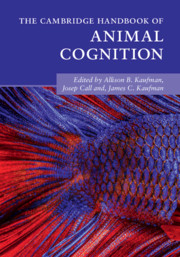Book contents
- The Cambridge Handbook of Animal Cognition
- The Cambridge Handbook of Animal Cognition
- Copyright page
- Dedication
- Contents
- Figures, Tables, and Boxes
- Contributors
- Acknowledgments
- Introduction
- Part I Communication and Language
- Part II Memory and Recall
- Part III Social Cognition
- Part IV Social Learning and Teaching
- 19 Social Learning and Teaching Overview
- 20 Tandem Running Recruitment by Temnothorax Ants as a Model System for Social Learning
- 21 Fish Social Networks
- 22 Social Learning in Birds
- 23 Social Learning in Chimpanzees
- Part V Numerical and Quantitative Abilities
- Part VI Innovation and Problem-Solving
- Index
- References
21 - Fish Social Networks
from Part IV - Social Learning and Teaching
Published online by Cambridge University Press: 01 July 2021
- The Cambridge Handbook of Animal Cognition
- The Cambridge Handbook of Animal Cognition
- Copyright page
- Dedication
- Contents
- Figures, Tables, and Boxes
- Contributors
- Acknowledgments
- Introduction
- Part I Communication and Language
- Part II Memory and Recall
- Part III Social Cognition
- Part IV Social Learning and Teaching
- 19 Social Learning and Teaching Overview
- 20 Tandem Running Recruitment by Temnothorax Ants as a Model System for Social Learning
- 21 Fish Social Networks
- 22 Social Learning in Birds
- 23 Social Learning in Chimpanzees
- Part V Numerical and Quantitative Abilities
- Part VI Innovation and Problem-Solving
- Index
- References
Summary
By responding to information gained through observing or interacting with other individuals, fish can learn about important aspects of their environment, including where to forage, how to recognize and avoid predators, and who to mate with. Social learning processes are often closely intertwined with the social environment; whether individuals engage in social learning, who they learn from, and what they learn frequently depend on complex, nonrandom patterns of social interaction. Social network analysis provides a sophisticated toolset for quantifying such elements of social structure. In this chapter, we discuss how integrating social network approaches with investigations into social learning have provided novel and important insights regarding the ways in which fish acquire and use social information in realistic social contexts.
Keywords
- Type
- Chapter
- Information
- The Cambridge Handbook of Animal Cognition , pp. 486 - 502Publisher: Cambridge University PressPrint publication year: 2021



